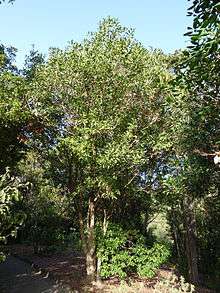Picconia
| Picconia | |
|---|---|
 | |
| Scientific classification | |
| Kingdom: | Plantae |
| (unranked): | Angiosperms |
| (unranked): | Eudicots |
| (unranked): | Asterids |
| Order: | Lamiales |
| Family: | Oleaceae |
| Tribe: | Oleeae |
| Genus: | Picconia DC. |
| Species | |
|
See text | |
Picconia (Picconia) is a genus of two species flowering plants in the family Oleaceae. In the laurel forests habitat, of Macaronesia islands of the eastern North Atlantic.[1]
Description
They are evergreen shrubs to trees with large, opposite, entire, shiny, ovoid leaves and numerous flowers. The fruit is a drupe. The flowers are small white and fragrant, followed by one-seeded, olive-like green fruit, ripening to bluish-black.[2] Picconia are native of open spots in the laurel forest of the Canary Islands and Madeira where they are found only in the humid to hyper-humid evergreen forests of the cloud belt.[3] Tree species with laurel-shaped leaves are predominant, forming a dense canopy up to 40 m high that can be hardly trespassed by light, which results in scant vegetation in the understory.[4] Most of these tree species in Africa are ancient paleoendemic[5] species of the genera Laurus, Ocotea, Persea, and Picconia, which in ancient times were widely distributed on the African and European continents.[6][7]
Species
- Picconia azorica - endemic to the archipelago of the Azores[8]
- Picconia excelsa - tree up to 15m; Madeira, Canaries
References
- Notes
- ↑ http://biblioteca.universia.net/html_bura/ficha/params/title/vegetative-propagation-of-the-endangered-azorean-tree-picconia-azorica/id/54598910.html
- ↑ http://www.rareplants.de/shop/prodtype.asp?strPageHistory=compare&CAT_ID=714
- ↑ http://ec.europa.eu/environment/nature/natura2000/management/habitats/pdf/9360_Macaronesian_laurel_forests.pdf
- ↑ http://ec.europa.eu/environment/nature/natura2000/management/habitats/pdf/9360_Macaronesian_laurel_forests.pdf
- ↑ http://rspb.royalsocietypublishing.org/content/273/1598/2149.full
- ↑ http://ec.europa.eu/environment/nature/natura2000/management/habitats/pdf/9360_Macaronesian_laurel_forests.pdf
- ↑ http://rspb.royalsocietypublishing.org/content/273/1598/2149.full
- ↑ Secretaria Regional do Ambiente e do Mar (2008), Plantas Endémicas dos Açores: Guia da Ilha do Faial, p.13
| Wikimedia Commons has media related to Picconia. |